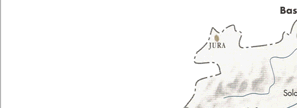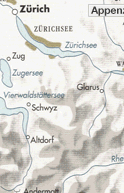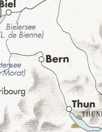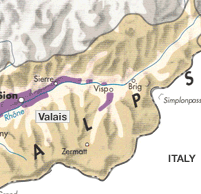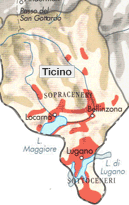Switzerland is best known for its chocolate, watches, banks, machine
industry and tourism, but this little country also produces great wines.
Vineyards were introduced by the Romans some 2,000 years ago as they
conquered Europe. The wide range of flavors and styles reflects the
incredible variety found in exposure, soil composition and the
micro-climates of Switzerland's numerous vineyards. Getting to know Swiss
wines means discovering these subtle differences in terroir and taste.
Approximately 75% of the production occurs in the vineyards of western
Switzerland, along Lake Geneva (Lac Léman in French) and south and south
east of the lake along the Rhône valley. Other vineyards are found around
Lake Neuchâtel in the west, in Ticino, south of the Alps, and in
northern, northeastern and eastern Switzerland, mainly in the Rhine
valley. Total vineyard surface is approximately 37,000 acres with a
production of over 34 million gallons, of which roughly 48% are whites
and 52% reds. The country is home to hundreds if not thousands of
wineries, and many more vineyard-owning families who pass their land from
generation to generation.
Very few foreigners know about Swiss wines, the reason being that
although Switzerland has been producing wines since the Roman era, its
production covers only roughly 30% of the domestic consumption, therefore
there is very little incentive to export. In fact, only 1-2% of its wine
production is exported yearly, and the bulk of it to the European Union.
If you are unfamiliar with Switzerland, it is located in the center of
western Europe, and the map above will help you familiarize yourself with
its main vine growing regions.
The cultural diversity of Switzerland with its four linguistic regions
(65% German in the East, 25% French in the West, 6.5% Italian in the
South and 0.5% Rheto-Romansh in the South East) adds to its wine
diversity, despite its very small size. At 41,285 km2 (15,940 sq mi), it
is 4 times smaller than Wisconsin, Swiss Cellars’ home state, and
with a population of 7.5mio has 33% more residents than Wisconsin does.
To give a sense of distances, it takes approx 3.5 hours to cross
Switzerland from West to East, as well as from North to South on its
interstate system. And it takes about 2-2.5 hours to drive through its
wine country from Geneva south into the Valais.
The dominating varietals include Chasselas (white), Pinot Noir, Gamay and
Merlot. Switzerland is home to some unique varietals, such as the
Chasselas, the most important white and cultivated in western
Switzerland. Other specialties include the Petite Arvine, Amigne and
Malvoisie (whites), Gamaret, Garanoir, Cornalin, Humagne Rouge and
Mondeuse (reds).
The appellation system varies by region. All regions have a main
appellation that is identical to the name of the canton (Valais, Ticino,
Neuchatel, Vaud, etc). Then Geneva and Vaud have adopted a Burgundy-like
AOC system.
The weather in Switzerland is generally moderate in the Swiss Plateau
(the East-West stretch of land relatively flat between the Jura mountains
in the North and the Alps in the South). On the Plateau, freezing
temperatures generally occur during December-early March with an average
temperature of 9 °C (48 °F) for elevations between 500–600 metres
(1,600–2,000 ft). On the Plateau, the average precipitation is
1,000 millimeters (39.4 in). The higher elevations of the Jura and the
Alps naturally cause lower temperatures and in the high Alps glaciers
exist. The Jura and foothills (both north and south of the Alps)
typically have more precipitation, with an average of 1,200–1,600
millimetres (47–63 in), while the high Alps may have over 2,500
millimetres (98 in). Ticino, on the south side of the Alps, has
sub-tropical vegetation and is usually 2-4°C (4-7° F) warmer and wetter
than the Swiss Plateau. In the Köppen climate classification, the Swiss
Plateau is classed as Maritime Temperate or Oceanic climate (Cfb) and the
Alps are considered Tundra climates or (ET). A maritime temperate area
will have changeable, often overcast weather. Summers are cool due to
cloud cover and winters are milder than expected due to latitude. The
Jura will be slightly cooler due to higher altitude. Within the Alps,
temperatures and snow fall correlate to altitude. (source:
wikipedia.org). The country’s coordinates are 47° N 8° E.
|

